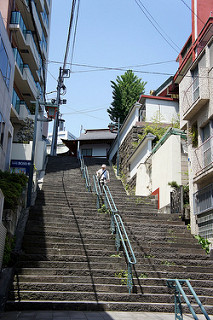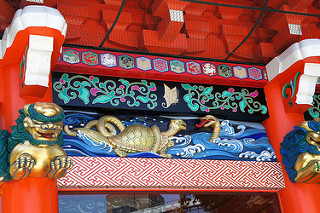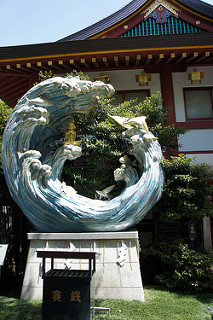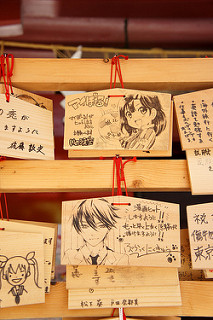Since I last wrote about Japanese literature that I’ve been reading, I’ve added a few more authors to the list.
I catalogue my books using Library Thing, so all links to book titles will go to that website. I don’t want to recommend any one book seller above another, but you will find links to online retailers from each book page.
I borrowed a book that my husband picked up in a small independent book store. It’s called A Riot of Goldfish and it’s by Kanoko Otamoto.
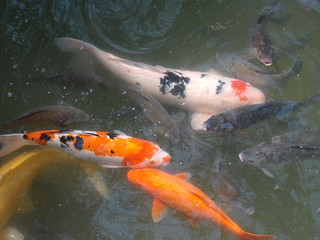
Carp in the moat at Hiroshima Castle
The book holds two poignant stories that explore frustration, self-worth and trying to make your mark in the world. Set in Japan in the years between the two 20th century world wars, they show a nation caught between the old feudal way of life and the thrusting modernity brought in by the Meiji era. The men are largely frustrated and unsettled by their inability to grasp the opportunities modernity seems to offer them, while the women float serenely above them. I found them an interesting pair of stories.
My husband bought me my next selection, The Thief by Fuminori Nakamura. This novel, about a pickpocket in Tokyo who becomes embroiled with a gang that is manipulating the political process, had my heart racing. It’s quite short, 210 pages, but it packs a lot in. Tightly written, believable in its exploration of a thief’s psychology, sympathetic to its main character, I wanted it to go on for longer. I wanted to know what happened next.
I can’t recall why I decided to pick up Jun’ichiro Tanizaki’s In Praise of Shadows, whether it was because we were planning to visit Ningyocho in Tokyo, where Tanizaki lived, or for some other reason. I’m glad I did, because I discovered another author whose style I like.
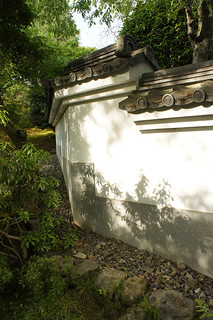
Shadows in the temple garden Tenryuji, Arashiyama
On the surface, the extended essay is an inconsequential set of ramblings about how Japan’s pursuit of Western illumination has ruined certain aesthetic traditions. I had to remind myself that it was written in the 1930s, at a time when Western-style “progress” was eating away at centuries of tradition in Japan. Tanizaki posits some interesting theories about why Japanese architecture and notions of beauty developed the way they did, embracing shadows and focusing on single aspects of beauty to be highlighted by the existence of the surrounding shade. I’m one of the Westerners he’s perplexed by – I love light, and often throw open curtains, doors and windows to let it into a gloomy room. But I also understand his love of muted light, natural light, preferring it to the harsh glare of electric light as he does. Japan has changed too much over the past 80 years for me to ever experience the aesthetics Tanuzaki appreciated and mourned, so I won’t ever be able to fully understand this essay, but I enjoyed it all the same. Having read that book, I then also read The Makioka Sisters and Some Prefer Nettles.
I found The Makioka Sisters to be an absorbing insight into the social niceties of early 20th century Japan. I enjoyed the humour and the tensions between the three sisters as they tried to navigate their way through society’s expectations and the changing times they lived in. The characterisations are beautiful, and I was immersed in the story completely. When we visited Aizen Kobo in Kyoto in May 2015, I was glad to have read this book so that I could converse about it with the lady of the shop. Jun’ichiro Tanizaki was a member of the same artistic group as the father of the current craftsman owner and gave Aizen Kobo its name.

Aizen Kobo
I didn’t enjoy Some Prefer Nettles quite as much. It lacked the spark of The Makioka Sisters, but some of the passages have remained with me, particularly the descriptions of attending a Bunraku performance.
I gave Banana Yoshimoto’s The Lake a try. The book is a good character study of two people struggling with the extraordinary and the mundane, working out a way to fit together. It’s moody but satisfying. I’ll read some more of hers.
Another new author to me was Yoko Ogawa. I started with The Housekeeper and the Professor, which I found deeply moving. I recommended it to so many people after I finished it. I also read Ogawa’s Hotel Iris, which is a very different book but no less compelling.
I chose Shuichi Yoshida’s Villain from the search results for Japanese authors on Amazon. This was a little depressing, but only because it was so well written. I felt a certain empathy for the central character and felt that Shūichi Yoshida made him a believable person. The book was an interesting exploration of alienation and the need to feel loved by someone, to feel that you belong. It wasn’t just a clichéd tale of an introverted loner turning out to be a serial killer. It was more an exploration of how life events mould us and can take us to extremes. I’ve now got Parade on my To Read pile.
After looking at the pictures Jacquie Hadel took on her visit to the titular dunes of Kobo Abe’s The Woman In The Dunes, I decided to read the book. It is a very strange book. The protagonist isn’t a pleasant character – dismissive of others, cold, aloof – and yet I found myself on his side. The book is quite dreamlike, with things happening off to the side of where you think you are. A simple trip to look for beetles turns into a living nightmare, full of frustration and anger. I didn’t like it, but I couldn’t stop reading it, and I had to unpack what I had read in conversation with my husband to stop it circling around my brain. It put me in mind of the Terry Gilliam film, Brazil, in its surreal gentle horror.
My best friend bought me The Guest Cat by Takashi Hiraide.
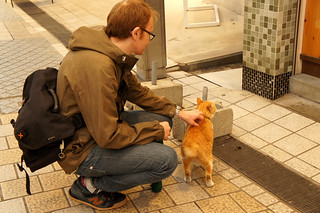
An opportunist proclaiming hunger to any passerby who would listen
This is a thoughtful, philosophical tale about the impact an animal can have on people, even when they don’t own the animal. It captures the aloof exploitative nature of a cat who charms a couple with its independence and seeming unavailability. When the cat disappears from their lives, it leaves them bereft and causes friction between them and their neighbour, the cat’s true owner. Set on the cusp of change, from Shōwa to Heisei, from economic bubble to slump, it inhabits a calm space bound by feline comings and goings. It also delivers a punch to the emotional solar plexus right in the middle of the story.
I saw a review of Strange Weather In Tokyo by Hiromi Kawakami which intrigued me, so I read it. It was a poignant, surreal and oddly touching book, about unrequited love changing to mutual love. The main character is adrift, moving through life aimlessly. A chance encounter with an old school teacher in a bar changes everything. At first, nobody knows where things are going, but then Tsukiko takes charge of a sort. The emotional remove between the two protagonists is at once frustrating and endearing. It made me think of Botchan at times, with the formality and hidden meanings and the way nobody seems to get to the point, of Murakami’s appreciation of loneliness at others.
A friend from Japanese class recommended that I try some Yasunari Kawabata, so I started with Snow Country. I absolutely loved this book. On the surface, nothing much seems to be going on. The two main characters lack energy, drifting along, reacting to events rather than controlling them, or controlling them through inaction. Beneath the surface is the potential for passion, but neither possesses the motivation to act. The book is dreamlike in the way it jumps around and seems to have meaning without saying anything clearly. The dysfunctional relationships across the piece intrigue and frustrate equally. The prose is beautiful, with rich descriptions of time and place, like an extended haiku. I found it quite cinematic. Kawabata is another author whose works I’m going to investigate further.
I also read a beautiful manga called The Walking Man by Jiro Taniguchi. The observations in the drawings are lovely, taking in the minutiae of Japanese suburban life. It made me think of times we have gone off the tourist trail to explore residential areas or visit small towns on the outskirts of big cities in Japan.
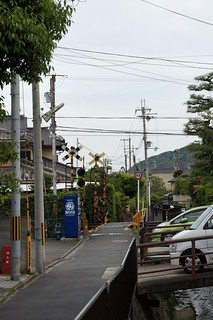
Arashiyama side street
Kanae Minato’s Confessions was made into a film which I saw at the cinema a couple of years ago. I decided to read the book because I wanted to see how it compared to the film, which I found a little inconsistent. The book is better, and the narration by the key characters is an interesting technique that was lost in the film version. There are inconsistencies in the story, contradictions that don’t boil down to different points of view, but it was an engaging read.
I was intrigued by the bizarrely named Edogawa Rampo (say it out loud, and it kind of sounds like the name of the American author he was trying to emulate), so I read a book of his short stories, Japanese Tales of Mystery and Imagination. I enjoyed this collection of mystery stories. They made me think of Tales of the Unexpected, but less salacious. There are some grim bits in a couple of the stories, but as a whole the collection is more about mystery and human nature than it is about horror or spookiness.
Finally for new reading experiences, I read The Pillow Book of Sei Shonagon. I enjoyed The Tale of Genji and the Diary of Lady Murasaki so much that I wanted to see what another writer from the same era had to say. What a mistake. Sei Shōnagon was a terrible snob! I enjoyed the passages describing events at court, conversations, and love affairs. The lists of what is and isn’t good were dull. Shōnagon’s attitude to those of lower rank grated on me. She seems to embody all that is worst in the rich and vacuous. Perhaps something was lost in translation, but I didn’t see how she came to have a reputation as a wit. I preferred the Diary of Lady Murasaki for its observations on court life and for its intelligence.

Dressed in Heian Era costume in the Jidai Matsuri
And in among all of these new writers, I read more by some of my existing favourites. I loved Haruki Murakami’s new novel, Colourless Tsukuru Tazaki and His Years of Pilgrimage. I also read the whole Sea of Fertility Tetralogy spread over a six month period in 2015. Mishima is a hard writer to digest, but I love the clarity of his prose, even when I don’t like or agree with what he’s saying. Spring Snow was my favourite of the four. I also read Sanshiro and The Gate by Sōseki. The Gate is now one of my favourite books of all time. I need to read And Then to complete that trilogy. I also read I Am A Cat, which I didn’t enjoy as much as I expected to. I expanded my experience of Ryu Murakami’s oeuvre by reading two more of his books. Audition was fairly graphic but, after my husband played up its content, not as graphic as I was expecting. Sixty Nine was an interesting read in that I started out hating the main character for his immature obnoxious character but ended up warming to him as the story unfolded.
And a book by a non-Japanese author but set in Japan that I enjoyed is A Tale for the Time Being by Ruth Ozeki. It’s not a completely happy read, but it is a good story. Part of it is set in Tokyo, where one of the characters spends time in a Maid Café.

There are a few non-fiction books that I’ve read, as well. I’ve reviewed Deep Kyoto Walks and In Search of Japan’s Hidden Christians separately. I’ll probably do separate reviews of the others I’ve read, too. Eventually!

